

VCSEL test
Focus on semiconductor electrical performance testing
Position:Home > Solutions > Semiconductor discrete devices
A vertical cavity surface emitting laser (VCSEL) is a laser that emits in a direction perpendicular to the P-N junction plane and the resonant cavity surface is parallel to the P-N junction plane.
The VCSEL is a semiconductor laser with the laser emission direction perpendicular to the P-N junction plane and the resonant cavity surface parallel to the P-N junction plane, which is a type of surface emitting laser. In contrast, the light of EEL edge-emitting lasers is emitted along the horizontal direction, from the edge of the chip. VCSELs are replacing conventional edge-emitting lasers in an increasing number of applications because of their more cost-effective and responsive production process compared to EELs.
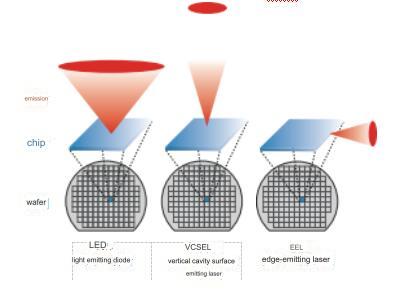
Figure: The working principle of different light-emitting devices
With the development of optoelectronics and information technology, especially after the upgrading of equipment and process improvement, VCSELs have made great progress in both performance and application. Due to the advantages of low threshold current, stable operating wavelength, good beam quality, and easy to form one- and two-dimensional integration and other advantages, VCSELs are widely used in optical communication, laser display, optical storage, consumer electronics and other fields.

Figure: Extensive applications of VCSEL sensing
Vertical cavity surface emitting lasers VCSELs have a complex semiconductor structure, but their packaging structure is generally simpler. Unlike edge-emitting laser diodes, which require EELs to be unbundled into Bar bars for yield testing, VCSELs can be tested prior to packaging for product selection, greatly reducing the cost of product risk. The VCSEL production process has three testing stages, all of which require a pulsed current source to test the device. A fast, flexible and accurate test solution is essential to reduce the cost of testing.
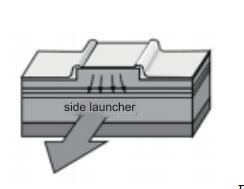
Figure: The light-emitting surface of EEL is the cleavage surface of the laser
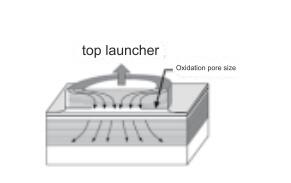
Figure: The active zone of VCSEL has reflective surfaces composed of Bragger gratings above and below
VCSEL common test parameters characterization
VCSEL devices are widely used for 3D face recognition and distance sensing. When VCSEL arrays are used in TOF modules, especially in dTOF systems of the excitation radar, the peak power, operating current, operating voltage, conversion efficiency, and near and far field optical characteristics of VCSELs in the narrow pulse case are very important for chip suppliers, packaging service providers, and module integrators.
VCSEL and VCSEL arrays, including various laser diode standard detection of key electrical performance technical parameters, common parameters such as laser diode forward voltage drop (VF), KinK point test/linearity test (dL/dI), threshold current (Ith), output optical power (PO) with slope efficiency (Es), etc.
The LIV test is a quick and easy way to determine the key performance parameters of VCSEL by combining two measurement curves in a single graph. The L/I curve shows the dependence of the laser's light intensity on the operating current and is used to determine the operating point and threshold current. The V/I curve shows the application to the voltage of the laser acts as a function of the operating current. Through the LIV (Light Intensity-Current-Voltage) test, most of the electrical parameter characteristics of VCSEL and the optimal output optical power can be evaluated.

The narrower the laser pulse width output by the radar, the higher the ranging accuracy; The greater the peak optical power, generally up to 100 watts, the farther the test distance. Therefore, it is important to study high-peak optical power VCSEL chips with high injection currents. The high-power laser uses direct current (DC) or wide pulse to power up the heat is serious, the laser effect is greatly affected by temperature, and the test results under DC or wide pulse cannot reflect the characteristics of the device. Therefore, in order to measure the performance of VCSEL devices in real working scenarios, microsecond or even nanosecond drive and test capability test equipment are required to test them, which is currently not realized by traditional DC or wide pulse test meters.
Typical solution of PL series narrow pulse LIV test system
In order to meet the needs of the VCSEL industry chain for narrow pulse LIV testing, PSS Instruments and the head enterprises in multiple application fields conducted in-depth discussions, combined with industrial needs and their own technology, launched PL narrow pulse LIV test system, the product has output current pulse narrow (ns level), large output pulse current (30A), support pulse light peak power detection, support laser voltage measurement, ultra-fast rise speed and other functions.
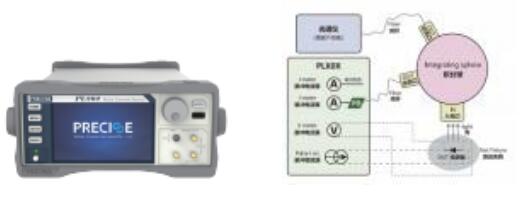
Figure: narrow pulse LIV test system and test system block diagram of the PSS PL series
The composition of PL series narrow pulse LIV test system is shown in the figure above: PL series pulse source, test fixture, integrating sphere, optical fiber, spectrometer, etc., spectrometer users can choose to purchase it according to their own needs.
Test principle
The LIV test uses a VCSEL pulse current power supply to measure the voltage across the device and the optical power of the device output. Using the PSS PL series pulsed constant
current source with the spectrometer can construct a standard VCSEL optical power test system: PL test system as a precision current pulse source, drive the VCSEL laser to emit different wavelengths of laser, the laser through a special integrating sphere to collect light, integrating sphere decays the light with a certain divergence angle, and then uses PD for photoelectric conversion, and then the system quickly samples the photocurrent to accurately measure the laser power output by the laser. The classic test principle combined with the excellent performance and strict specifications of the PSS PL test system has helped users complete a series of challenging test projects.

Figure: PL series LIV narrow pulse test system
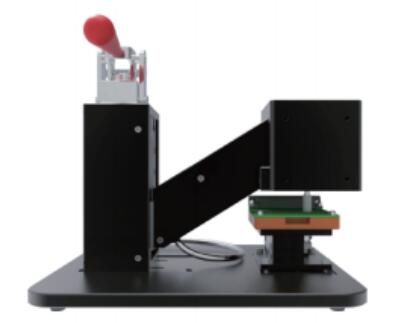
Figure: Manual test fixture for TO type laser
System advantages
Set a variety of functions in one: fast pulse generator + programmable current source + peak sampling optical power meter + pulse voltmeter
PL series LIV test system has the characteristics of good synchronization performance, fast test speed and complete solution;
Through the digitization function of 15MS/s, 0.1% basic measurement accuracy of the pulse generator is achieved;
Ultra-narrow pulses to the ns level, duty ratio can be as low as 0.01%;
Multiple precision photocurrent test ranges;
The LIV algorithm of the upper computer and the automatic calculation of various parameters and simplifies the application.
High fidelity of the pulse: no overshoot, no oscillation
The PL series LIV test system ensures that pulses in the μs range are output within the output current capability without overshoot and oscillation. The fastest pulse rise time of 300A/μs ensures that the user can correctly detect the circuit or device under test.
Maximum 30A pulse current output;
Compatible with CW and QCW modes, precise pulse width adjustable technology;
Ultra-high-speed pulse sampling technology ensures accurate sampling data under narrow pulses.
Higher test current
With the rapid development of high-power lasers, the driving current of lasers is increasing, resulting in 30A cannot meet the driving needs of some lasers. At this time, we can connect up to 4 PSS PL series devices in parallel to provide a maximum drive current of 120A pulse width in the μs range, still the same LIV testing of high-power lasers is implemented on an upper computer software.
Upper computer test software
In order to meet the needs of users, the PL series narrow pulse LIV test system is equipped with a dedicated upper computer software. A number of test parameters can be directly set in the software, and the software will automatically calculate the relevant parameters after the test is completed, so as to facilitate customers to achieve rapid testing and improve test efficiency.
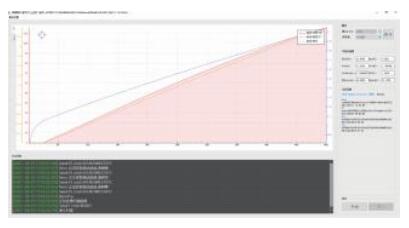
Figure: LIV test result interface of upper computer
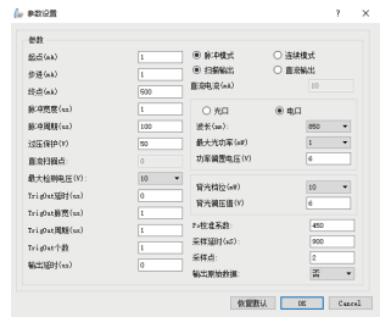
Figure: upper computer software setting interface
PSS PL series narrow pulse system LIV test scan Forward voltage (VF) test
It refers to the forward voltage value corresponding to the laser operating under a certain forward drive current (generally Ith+20mA), including the bandgap voltage VBG of the laser and the voltage drop I*RL of the equivalent series resistance.
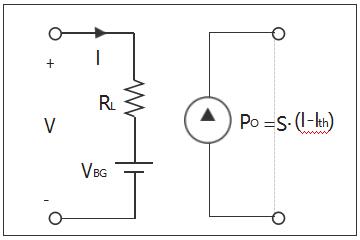
Figure: Forward voltage equivalent circuit diagram
Threshold current (Ith) test
It refers to the forward current value of the VCSEL laser when it is converted from spontaneous radiation to the stimulated radiation state, which is related to the material and structure of the laser. It is important to note that the threshold current usually increases at high temperatures, so the module's temperature compensation bias and modulation currents usually increase. The threshold current can be measured by a LIV curve.
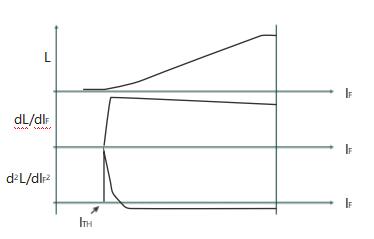
Figure: Illustration of threshold current calculation
Light intensity (L) test
Light intensity (L) measurement tests the light output of VCSEL. As the drive current increases, so does the optical output power. The output of light intensity measurements is generally measured in mW.
Optical power measurement requires a calibrated integrating sphere, fiber and detector system. The calibration information, i.e. correction factor PO, is a wavelength-dependent value that can be determined during calibration.

Figure: Light intensity (L) test interface
Optical characteristic parameter test
In addition, in the measurement of optical parameters such as VCSEL spectral characteristics, the tester still needs a current source to power the device, and there are two modes according to the actual application: CW and QCW mode. It is recommended to use PSS PL series narrow pulse test system integration, PL series as a constant current source can also provide I/O interface and reasonably designed test fixtures for spectrometers, other automation equipment, expansion interfaces, etc., so as to realize the full parameter automatic test of the test machine.
*Test Note: The effect of equivalent inductance on narrow pulse test

Figure: Schematic of the effect of equivalent inductance on pulse output
As shown in the figure, both the fixture and the output line have distributed inductance parameters, especially the influence of inductance on narrow pulses is particularly important. The focus is on narrow pulses, because the rapid current rise rate (di/dt), combined with the inductor L, will cause a large back pressure and similar problems occur when the current drop rate is large. This overshoot or reverse overshoot can cause damage to the device.
* Type of test fixture
For narrow pulse testing needs, PSS designed fixtures that fit a variety of packages. The fixture design needs to meet the small distribution parameters, temperature control, and manual automatic integration of integrating spheres, etc., which can meet the testing needs of different packaging devices of VCSEL under various circumstances. Some fixture drawings are as follows:

Rich product line, multi-channel aging power supply to meet the needs of VCSEL laser aging test
Since the advent of semiconductor lasers, due to its material and structural characteristics, it is facing the problem of reduced service life, and it is necessary to conduct aging tests on laser chips to screen out components with potential quality problems to meet their working time of millions of hours.
For the aging power supply needs of VCSEL test systems, PSS's rich product line can also perfectly cope with it. The maximum number of multi-channel aging power supply can reach 40CH, each channel can be independently controlled, synchronous test, independent output, flexible configuration, to help VCSEL aging test to achieve accurate and efficient.

Figure: PSS 1010C host + CBI402 daughter card
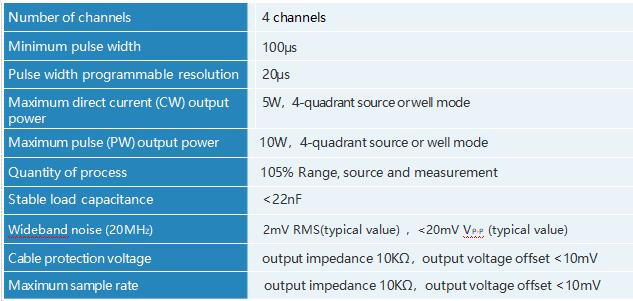
Figure: CBI402 daughter card parameters
For more VCSEL/laser diode test information or seek system selection help, welcome to log in to Wuhan Precise Instrument Limited Company (www.whpssins.com) or follow the WeChat public account (whpssins_com) of the official website of Psychic Instruments to contact us.